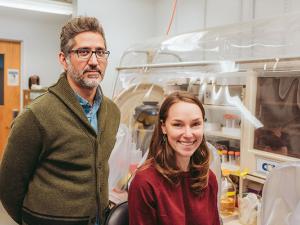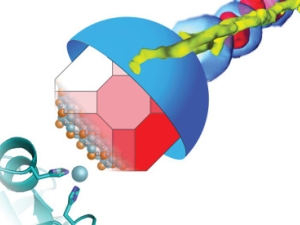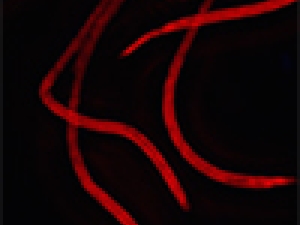

Research Bio
Summary: Despite their apparent simplicity, bacterial cells are defined by a high degree of subcellular complexity and organization. One of the more dramatic examples of subcellular differentiation is the formation of protein- and lipid-bounded organelles by a variety of bacterial species. One such organelle, the magnetosome, is lipid-bounded and houses the machinery to build nano-sized magnetite crystals. We use magnetosomes as a model to understand the molecular mechanisms of compartmentalization and biomineral production. More recently we have discovered and are studying ferrosomes as a new model organelle responsible for iron storage in diverse bacteria and archaea. We have four current areas of research which are summarized below.
Genetics of Magnetosomes: Magnetotactic bacteria produce magnetosomes through a complex and tightly controlled process. This process is controlled by genes that are typically organized into magnetosome gene clusters or islands. In the Komeili lab, we have developed the tools to understand the molecular basis of magnetosome formation and magnetite biomineralization in the bacterium Magnetospirillum magneticum AMB-1. These advances have helped us to uncover the potential function of a large number of magnetosome genes, including a core set of genes that regulate nearly every step of magnetosome formation, including magnetosome membrane formation, magnetite biomineralization, and magnetosome chain alignment.
Magnetosome Cell Biology: Proteins necessary for each of the steps of magnetosome formation have been identified in Magnetospirillum magneticum AMB-1, but the mechanisms of these fundamental processes are still poorly understood. While the regulation of magnetosome size has mainly focused on the magnetic crystals, we have found that the membrane surrounding individual crystals may play a greater role than previously expected. In addition, the spacing of magnetosomes and their orientation as a chain along the negatively curved inner membrane is also a complex and tightly regulated process.
Diversity of Magnetosomes: Magnetotactic bacteria are incredibly diverse and display stunning variety in chain arrangement, crystal morphology, and the quantity of their magnetosomes. We are interested in understanding the basis of this phenotypic diversity by developing other magnetotactic bacteria for genetic and molecular work. In particular, we are working with Desulfovibrio magneticus RS-1, a bacterium that produces tooth-shaped crystals as opposed to the cubo-octahedral crystals of Magnetospirillum magneticum AMB-1. Tooth-shaped magnetite crystals and greigite crystals are only found in deeper branching magnetotactic bacteria and uncovering the mechanism behind the synthesis of these crystals could give us insight into the evolution of magnetosomes.
Ferrosome Formation & Function: In addition to making magnetosomes, Desulfovibrio magneticus RS-1 makes another type of organelle that stores iron called a ferrosome. Ferrosomes appear to be surrounded by a lipid-like membrane, suggesting that ferrosome formation involves membrane invagination and iron storage via specialized proteins. Using proteomics and genetics, we discovered the genetic basis for ferrosomes and are now pursuing diverse bacteria to address our questions of ferrosome formation.
Research Expertise and Interest
microbiology, Biomineralization, bacterial organelles, magnetic nanoparticles
In the News
Mining with Microbe “Animal Magnetism”
Seven new Bakar Fellows already are making an impact
How bacteria get their magnetic compass
Many bacteria build miniature magnets and use them to navigate their environment, and UC Berkeley’s Arash Komeili has found a neat trick they use to do it.




